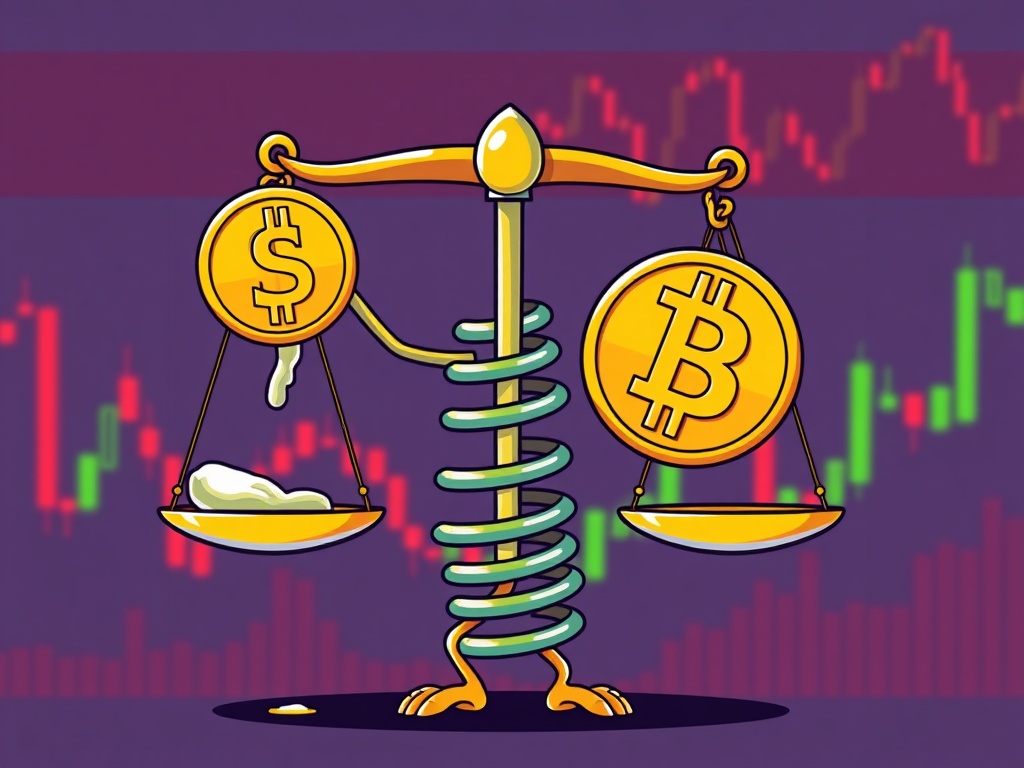BitcoinWorld

Bitcoin Futures: Unveiling the Ominous Downward Pressure and Hidden Opportunity
The world of cryptocurrency is a fascinating tapestry of innovation, volatility, and unexpected turns. For those deeply immersed in this digital frontier, understanding market signals is paramount. Recently, the spotlight has been on the Bitcoin futures market, which has presented some intriguing, albeit concerning, data points that demand our attention. What exactly is happening, and what could it mean for the price of Bitcoin?
Understanding the Alarming Dip in Bitcoin Futures Net Position
In the dynamic realm of cryptocurrency trading, futures contracts play a pivotal role, allowing traders to speculate on the future price of an asset without owning the underlying asset itself. A crucial metric within this space is ‘Open Interest’ (OI), which represents the total number of outstanding derivative contracts that have not yet been settled. When we talk about the ‘OI net position,’ we are looking at the difference between long and short positions, providing insight into the overall market sentiment.
Recently, a notable update from CryptoQuant analyst Axel Adler Jr. on X highlighted a significant shift: the open interest (OI) net position in the Bitcoin futures market has plummeted below $100 million. This isn’t just a minor fluctuation; Adler Jr. specifically pointed out that this marks the strongest downward pressure observed since early July. To put this into perspective:
- What is OI Net Position? It indicates whether the market is net long (more buyers expecting price increases) or net short (more sellers expecting price decreases). A negative net position suggests a dominance of short positions.
- Significance of $100 Million: Dipping below this threshold, especially after a period of relative stability, signals a strong bearish sentiment among futures traders.
- Historical Context: Comparing it to early July provides a historical benchmark, indicating that the current bearish pressure is not typical and warrants close observation.
This decline suggests that a substantial number of traders are betting against Bitcoin’s immediate price action, potentially leading to continued selling pressure. However, the market rarely moves in a straight line, and these extreme conditions can sometimes pave the way for surprising reversals.
Decoding Downward Pressure in the Bitcoin Futures Market: Why is BTC Resilient?
When analysts speak of ‘downward pressure,’ they are referring to a situation where there is a strong inclination for an asset’s price to fall. This is typically driven by a surplus of sellers over buyers, or in the case of futures, a preponderance of short positions. For Bitcoin, this means that despite fundamental interest, the sentiment in the derivatives market is heavily skewed towards a decline.
Given such pronounced bearish signals from Bitcoin futures, one might expect BTC’s spot price to be plummeting. Yet, as Axel Adler Jr. also noted, Bitcoin has remarkably continued to circle around the $115,000 mark. This apparent resilience in the face of strong bearish futures data begs the question: why isn’t BTC collapsing?
The answer, according to the analyst, lies in the actions of spot market participants: buyers are absorbing some of the selling volume. This indicates a fascinating divergence:
| Market Segment | Observed Behavior | Implication |
|---|---|---|
| Bitcoin Futures Market | Strong net short positions, downward pressure. | Traders are betting on lower prices. |
| Bitcoin Spot Market | Price holding steady around $115,000. | Real demand is absorbing selling pressure. |
This absorption suggests that despite the bearish sentiment in the derivatives market, there’s underlying demand for Bitcoin, perhaps from long-term holders, institutional investors, or retail buyers who see the current levels as an attractive entry point. This dynamic creates a tense standoff, where the market is primed for a significant move once one side gains a decisive advantage.
The Enigmatic Short Squeeze: A Potential Catalyst for Bitcoin Futures?
While the immediate outlook might seem bearish due to the overwhelming short positions in Bitcoin futures, this very extremity can become a powerful catalyst for a sharp upward reversal. This phenomenon is known as a ‘short squeeze.’ So, what exactly is it, and how could it impact Bitcoin?
A short squeeze occurs when a heavily shorted asset suddenly rises in price, forcing short sellers to buy back shares to cover their positions. Here’s a breakdown:
- The Setup: A large number of traders open short positions, betting that an asset’s price will fall.
- The Trigger: The asset’s price begins to rise, even slightly, perhaps due to unexpected positive news, a sudden surge in buying interest, or simply reaching a support level.
- The Squeeze: As the price rises, short sellers face increasing losses. To limit these losses, they are forced to ‘cover’ their positions by buying back the asset.
- The Spiral: This forced buying further pushes the price up, triggering more short sellers to cover, creating a cascading effect that can lead to a rapid and dramatic price surge.
Axel Adler Jr. specifically highlighted that such an “extreme negative OI divergence could serve as a catalyst for a short squeeze on any sustained price rebound.” This means that the current imbalance, with so many traders shorting Bitcoin, has created a highly volatile situation where any positive momentum could trigger a violent upward move. The ‘benefits’ of a short squeeze, for those on the long side or those who haven’t shorted, are substantial: rapid profit generation as the price rockets upwards, often defying previous expectations.
This potential for a short squeeze is the ‘hidden opportunity’ in the current seemingly ominous market. It’s a reminder that extreme bearish sentiment can sometimes be a precursor to a powerful reversal, especially in volatile markets like crypto.
Navigating the Risks: When Does Bearish Pressure in Bitcoin Futures Persist?
While the prospect of a short squeeze is enticing, it’s crucial to acknowledge the flip side: the risk of further downside still exists. The analyst cautioned that this risk persists “as long as the OI remains within the maximum bearish pressure zone.” But what does this ‘maximum bearish pressure zone’ entail, and what are the challenges for traders in such an environment?
The ‘maximum bearish pressure zone’ refers to a range of OI net positions where short positions significantly outweigh long positions, indicating an overwhelming consensus among futures traders that prices will continue to fall. In this zone, even minor positive news might not be enough to overcome the entrenched bearish sentiment and trigger a short squeeze. Key challenges include:
- Sustained Selling: If new short positions continue to open, or existing ones are held firmly, the downward pressure can persist, leading to further price declines.
- Lack of Buying Momentum: Without significant spot market buying or a fundamental catalyst, the price may struggle to find support and continue its descent.
- Liquidation Cascades: While a short squeeze involves short sellers covering, a sustained downturn can also lead to liquidation of long positions, further exacerbating price drops.
Traders must remain vigilant. The market is currently a battleground between strong bearish sentiment in derivatives and resilient spot market demand. Understanding when the bearish pressure might abate, or when the conditions for a short squeeze truly align, requires careful observation of both price action and underlying market structure.
Actionable Insights for Traders and Investors in the Bitcoin Futures Market
Navigating a market characterized by extreme bearish signals and the potential for a powerful reversal requires a thoughtful approach. Here are some actionable insights for those participating in or observing the Bitcoin futures market:
- Monitor Open Interest (OI) Closely: Pay attention to the OI net position. A sustained move out of the ‘maximum bearish pressure zone’ could signal a shift in sentiment. Look for patterns where OI begins to decline as price rises, indicating short covering.
- Observe Spot Market Absorption: The fact that buyers are absorbing selling volume is critical. Watch for increasing spot trading volumes on dips, which would confirm underlying demand and strengthen the case for resilience.
- Identify Key Price Levels: Establish strong support and resistance levels. A sustained break above a key resistance level could be the ‘sustained price rebound’ needed to trigger a short squeeze. Conversely, a break below strong support could signal further downside.
- Implement Robust Risk Management: Given the volatile nature of short squeezes and bearish pressure, strict risk management is paramount. Use stop-loss orders to limit potential losses on both long and short positions. Avoid over-leveraging.
- Diversify Your Portfolio: While tempting to focus solely on Bitcoin, consider diversifying your crypto portfolio to mitigate risks associated with single-asset volatility.
- Stay Informed: Follow reputable analysts like Axel Adler Jr. and platforms like CryptoQuant. Market updates and insights from experienced professionals can provide invaluable context.
Remember, the crypto market is inherently unpredictable. While analysis provides a framework for understanding, personal due diligence and a disciplined trading strategy are your best allies.
Conclusion: A Tense Standoff in the Bitcoin Futures Arena
The current state of the Bitcoin futures market presents a fascinating paradox: overwhelming bearish pressure from short positions, yet a surprising resilience in BTC’s spot price, thanks to diligent buyers. This creates a high-stakes environment where two powerful forces are in a tense standoff.
The insights from CryptoQuant analyst Axel Adler Jr. underscore this duality. While the dip in OI net position below $100 million signals significant downward pressure – the strongest since early July – it also sets the stage for a potentially explosive short squeeze. Such an event, triggered by any sustained price rebound, could lead to a rapid upward surge as short sellers scramble to cover their positions.
However, the risk of further downside looms as long as the market remains within the ‘maximum bearish pressure zone.’ For traders and investors, this is a moment that demands heightened awareness, careful analysis, and strategic decision-making. By understanding the dynamics of open interest, the mechanics of a short squeeze, and the persistent risks, participants can better navigate these choppy waters and potentially capitalize on the opportunities that emerge from such extreme market conditions. The future of Bitcoin’s price, at this juncture, hangs precariously balanced between powerful bearish forces and the potential for a dramatic reversal.
Frequently Asked Questions (FAQs) about Bitcoin Futures and Market Dynamics
Q1: What is ‘Open Interest (OI) Net Position’ in Bitcoin Futures?
A1: Open Interest (OI) refers to the total number of outstanding futures contracts that have not yet been settled. The ‘net position’ is the difference between the total long contracts and total short contracts. A negative net position, as seen recently, indicates that there are more short positions (bets on price decline) than long positions (bets on price increase) in the market.
Q2: What does ‘downward pressure’ mean for BTC’s price?
A2: Downward pressure indicates a prevailing sentiment or market condition where sellers outnumber buyers, or short positions dominate. For BTC, this means there’s a strong tendency for its price to fall due to increased selling activity or bearish bets in the derivatives market.
Q3: How does a ‘short squeeze’ work in the context of Bitcoin Futures?
A3: A short squeeze occurs when an asset’s price begins to rise, forcing traders who had ‘shorted’ (bet on a price decline) the asset to buy it back to cover their positions and limit losses. This forced buying creates additional demand, which further pushes the price up, leading to a rapid and often dramatic price surge as more short sellers are ‘squeezed’ out of their positions.
Q4: What is the ‘maximum bearish pressure zone’ for Bitcoin Futures?
A4: The ‘maximum bearish pressure zone’ refers to a specific range or level of the OI net position where short interest is overwhelmingly high. In this zone, bearish sentiment is deeply entrenched, and the market is highly susceptible to continued price declines unless a significant positive catalyst emerges to trigger a reversal.
Q5: Is it advisable to trade Bitcoin Futures based solely on OI data?
A5: While Open Interest data, especially the net position, provides valuable insights into market sentiment and potential future movements like short squeezes, it should not be the sole basis for trading decisions. It’s crucial to combine OI analysis with other technical indicators, fundamental analysis, risk management strategies, and broader market context for a comprehensive trading approach.
If you found this analysis insightful, please consider sharing it with your network! Your support helps us continue to provide timely and comprehensive market updates.
To learn more about the latest Bitcoin market trends, explore our article on key developments shaping Bitcoin price action.
This post Bitcoin Futures: Unveiling the Ominous Downward Pressure and Hidden Opportunity first appeared on BitcoinWorld and is written by Editorial Team





